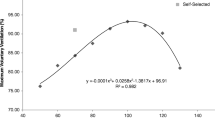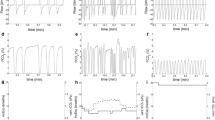Abstract
Purpose
The aim of this study is to investigate the individuality of airflow shapes during volitional hyperventilation.
Methods
Ventilation was recorded on 18 healthy subjects following two protocols: (1) spontaneous breathing (SP1) followed by a volitional hyperventilation at each subject’s spontaneous (HVSP) breathing rate, (2) spontaneous breathing (SP2) followed by hyperventilation at 20/min (HV20). HVSP and HV20 were performed at the same level of hypocapnia: end tidal CO2 (FETCO2) was maintained at 1 % below the spontaneous level. At each breath, the tidal volume (VT), the breath (TTOT), the inspiratory (TI) and expiratory durations, the minute ventilation, VT/TI, TI/TTOT and the airflow shape were quantified by harmonic analysis. Under different conditions of breathing, we test if the airflow profiles of the same individual are more similar than airflow profiles between individuals.
Results
Minute ventilation was not significantly different between SP1 (6.71 ± 1.64 l·min−1) and SP2 (6.57 ± 1.31 l·min−1) nor between HVSP (15.88 ± 4.92 l·min−1) and HV20 (15.87 ± 4.16 l·min−1). Similar results were obtained for FETCO2 between SP1 (5.06 ± 0.54 %) and SP2 (5.00 ± 0.51 %), and HVSP (4.07 ± 0.51 %) and HV20 (3.88 ± 0.42 %). Only TI/TTOT remained unchanged in all four conditions. Airflow shapes were similar when comparing SP1-SP2, HVSP-HV20, and SP1-HVSP but not similar when comparing SP2-HV20.
Conclusions
These results suggest the existence of an individuality of airflow shape during volitional hyperventilation. We conclude that volitional ventilation alike automatic breathing follows inherent properties of the ventilatory system.
Registered by Pascale Calabrese on ClinicalTrials.gov, # NCT01881945.



Similar content being viewed by others
Abbreviations
- FETCO2 :
-
End tidal CO2
- HVSP :
-
Voluntary hyperventilation at the spontaneous breathing rate
- HV20 :
-
Voluntary hyperventilation at a breathing rate of 20/min
- SP1 :
-
Spontaneous breathing of protocol 1
- SP2 :
-
Spontaneous breathing of protocol 2
- TI :
-
Inspiratory breath duration
- TE :
-
Expiratory breath duration
- TTOT :
-
Breath duration (TI + TE)
- VT :
-
Tidal volume
- VT × 60/TTOT :
-
Minute ventilation
References
Bachy JP, Eberhard A, Baconnier P, Benchetrit G (1986) A program for cycle-by-cycle analysis of biological rhythms. Application to respiratory rhythm. Comput Methods Program Biomed 23:297–307
Benchetrit G (2000) Breathing patterns in humans: diversity and individuality. Respir Physiol 122:123–129
Benchetrit G, Shea SA, Pham-Dinh T, Bodocco S, Baconnier P, Guz A (1989) Individuality of breathing patterns in adults assessed over the time. Respir Physiol 75:199–210
Calabrese P, Dinh TP, Eberhard A, Bachy JP, Benchetrit G (1998) Effects of resistive loading on the pattern of breathing. Respir Physiol 113:167–179
Corfield DR, Murphy K, Guz A (1998) Does the motor cortical control of the diaphragm ‘bypass’ the brain stem respiratory centres in man? Respir Physiol 114:109–117
Dejours P, Betchel-Lambrousse Y, Monzein P, Raynaud J (1961) Etude de la diversité des régimes ventilatoires chez l’homme. J Physiol 53:320–321
Edelman GM, Gally JA (2001) Degeneracy and complexity in biological systems. Proc Natl Acad Sci 98:13763–13768
Eisele JH, Wuyam B, Savourey G, Eterradossi J, Bittel JH, Benchetrit G (1992) Individuality of breathing patterns during hypoxia and exercise. J Appl Physiol 72:2446–2453
Gray JS, Grodins FS (1951) Respiration. Annu Rev Physiol 13:217–232
Haouzi P (2011) Initiating inspiration outside the medulla does produce eupneic breathing. J Appl Physiol 110:854–856
Haouzi P, Bell HJ (2009) Control of breathing and volitional respiratory rhythm in humans. J Appl Physiol 106:904–910
Hornsveld H, Garssen B, Van Spiegel P (1995) Voluntary hyperventilation: the influence of duration and depth on the development of symptoms. Biol Psychol 40:299–312
McKay LC, Evans KC, Frackowiak RS, Corfield DR (2003) Neural correlates of voluntary breathing in humans. J Appl Physiol 95:1170–1178
Mellen NM (2010) Degeneracy as a substrate for respiratory regulation. Respir Physiol Neurobiol 172:1–7
Meric H, Calabrese P, Pradon D, Lejaille M, Lofaso F, Terzi N (2014) Physiological comparison of breathing patterns with neurally adjusted ventilatory assist (NAVA) and pressure-support ventilation to improve NAVA settings. Respir Physiol Neurobiol 195:11–18
Proctor DF, Hardy JB (1949) Studies of respiratory airflow. 1. Significance of the normal pneumotachogram. Bull Johns Hopkins Hosp 85:253–280
Shea SA, Guz A (1992) Personnalité ventilatoire-An overview. Respir Physiol 87:275–291
Shea SA, Benchetrit G, Pham-Dinh T, Hamilton RD, Guz A (1989) The breathing patterns of identical twins. Respir Physiol 75:211–223
Shea SA, Horner RL, Benchetrit G, Guz A (1990) The persistence of a respiratory personality in stage IV of sleep in man. Respir Physiol 80:33–44
Author information
Authors and Affiliations
Corresponding author
Ethics declarations
Conflict of interest
The authors declare that they have no conflict of interest.
Ethical approval
All procedures performed in this study involving human participants were carried out in accordance with the ethical standards of the institutional research committee and with the 1964 Helsinki declaration and its later amendments or comparable ethical standards.
Informed consent
Informed consent was obtained from all individual participants included in the study.
Additional information
Communicated by Susan Hopkins.
Rights and permissions
About this article
Cite this article
Besleaga, T., Blum, M., Briot, R. et al. Individuality of breathing during volitional moderate hyperventilation. Eur J Appl Physiol 116, 217–225 (2016). https://doi.org/10.1007/s00421-015-3260-3
Received:
Accepted:
Published:
Issue Date:
DOI: https://doi.org/10.1007/s00421-015-3260-3




